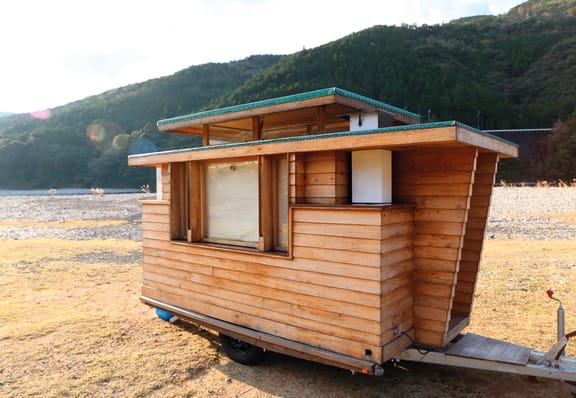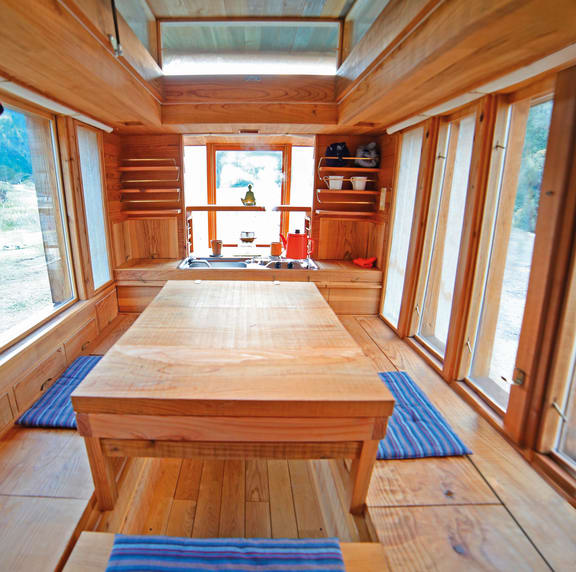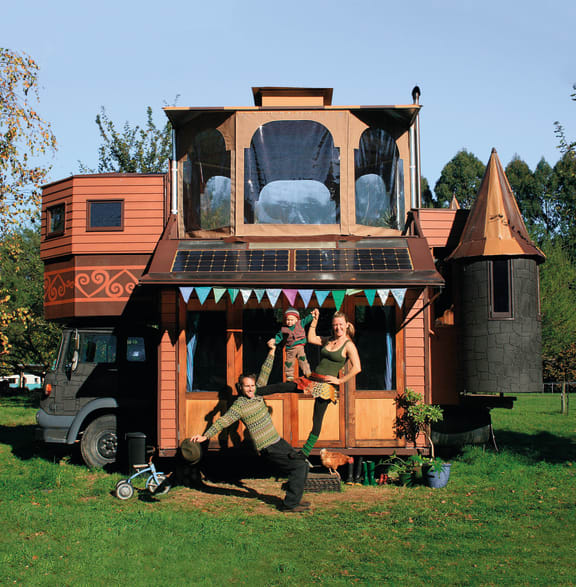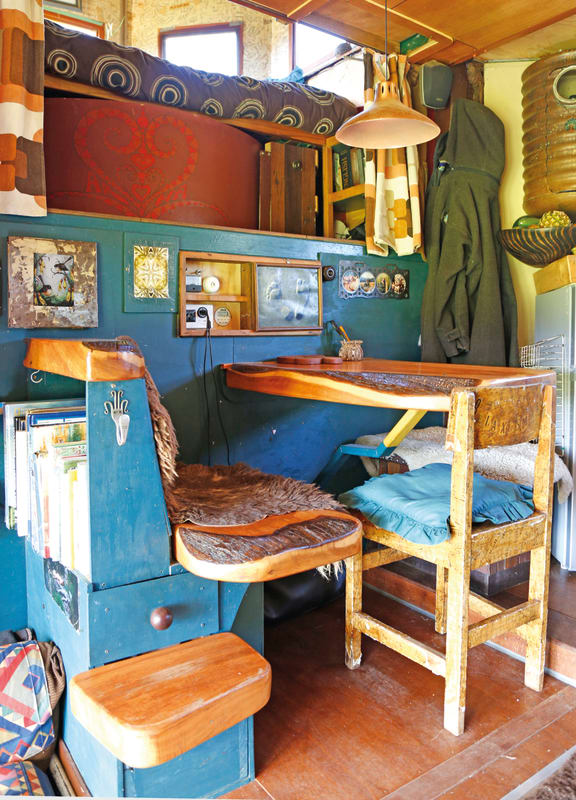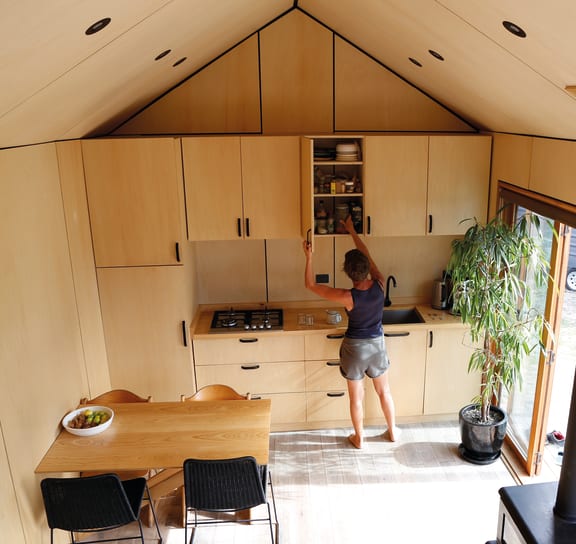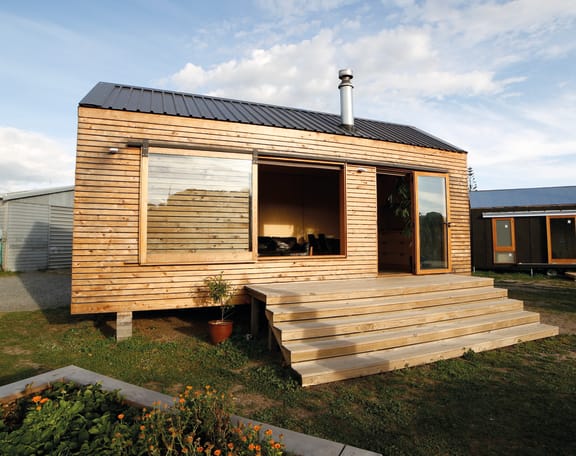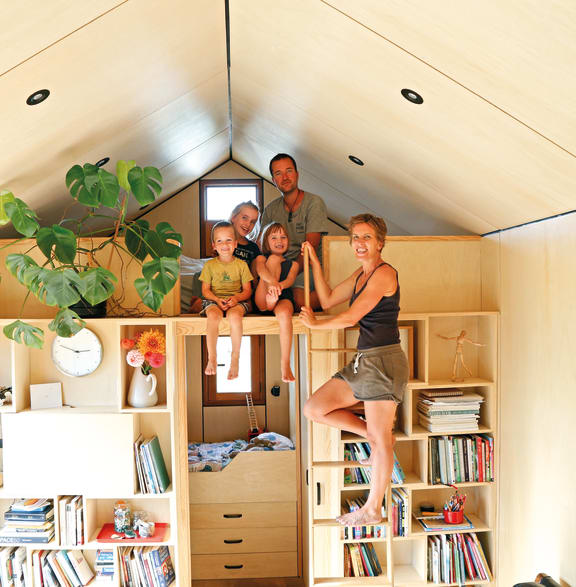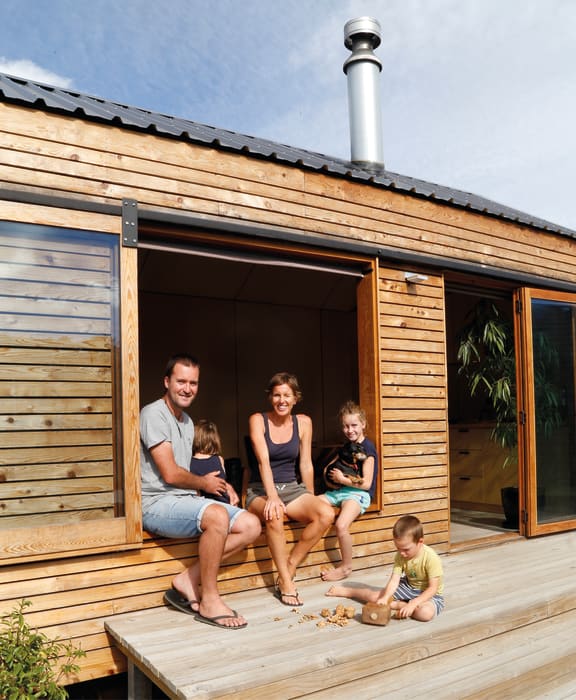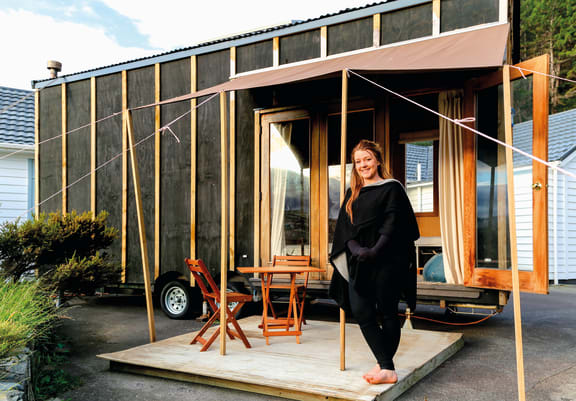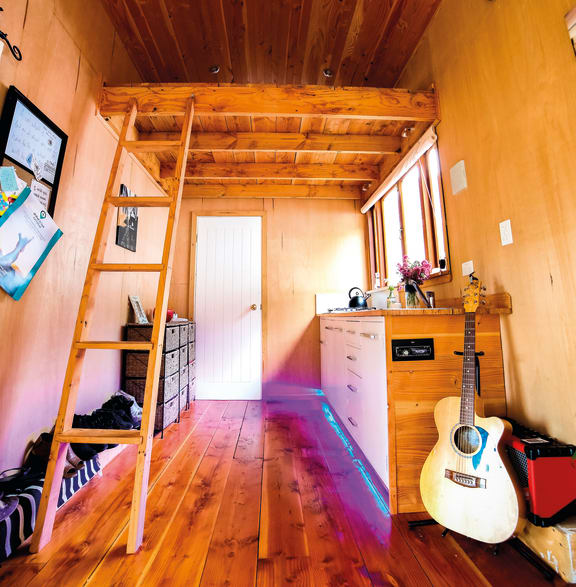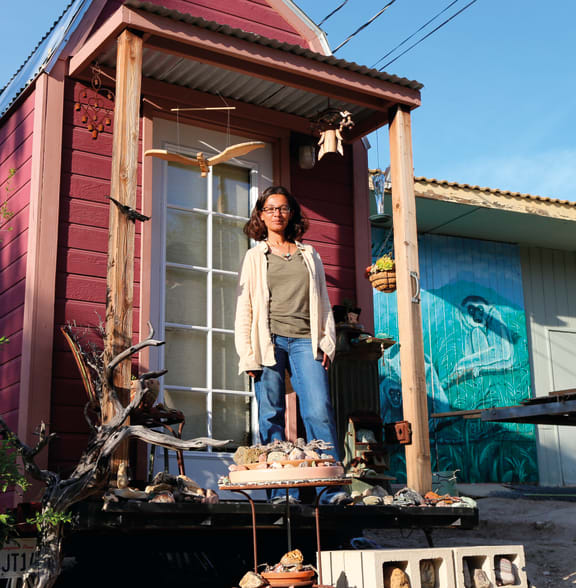Tiny houses on wheels are wonderful, cosy, romantic, comfortable spaces, Kiwi actor and YouTube star Bryce Langston says, but he happily accepts they're not for everyone.
Langston is a New Zealand-based actor with stints on Shortland Street and Spartacus, a musician, filmmaker and environmentalist.
He has spent the past five years traveling the globe exploring the tiny house movement as the creator and host of the popular YouTube series, Living Big in a Tiny House.
With one million subscribers and over 120 million views, Living Big in a Tiny House is one of New Zealand's most successful YouTube shows.
Langston has also just finished building his own tiny house - and released a book, Living Big in a Tiny House, which showcases some 50 innovative, small-space dwellings in the US, Canada, Japan, Australia and New Zealand.
He says tiny houses are less about specific size in square metre and more about smart design.
"Keeping them focused on small, affordable and very efficient.
"You know, certainly for a family of four for instance I wouldn't expect them to want to live in a 15 square metre home, and a 60 square metre home might be a more appropriate tiny house for a family of four individuals so I think it really depends on your circumstances."
He says he's not evangelising or preaching, and indeed warns that living in a tiny house is not for everyone.
"I am not gonna sit here and tell you that everyone should live in a tiny house, because that is exactly not what should happen.
"I have no interest in changing anybody's mind ... I'm more than happy for them to live in the way that they choose but there are individuals out there who are struggling under the current paradigm, and I would love for people to know that this is an option for them, that it's out there, that people are doing it, that people are doing it really successfully.
"I think there is a very specific kind of individual who is very well suited to tiny house living.
"They tend to be people who are quite minimal anyway, they're people who like to live simply, they're people who often like to live their lives outside of their homes and there's a whole spectrum of people - from lawyers and accountants to crazy wild artists and it's just all walks of life - but what they do have in common is they tend to be people who appreciate really simple living."
He says building his own tiny house on wheels was partly an economic decision.
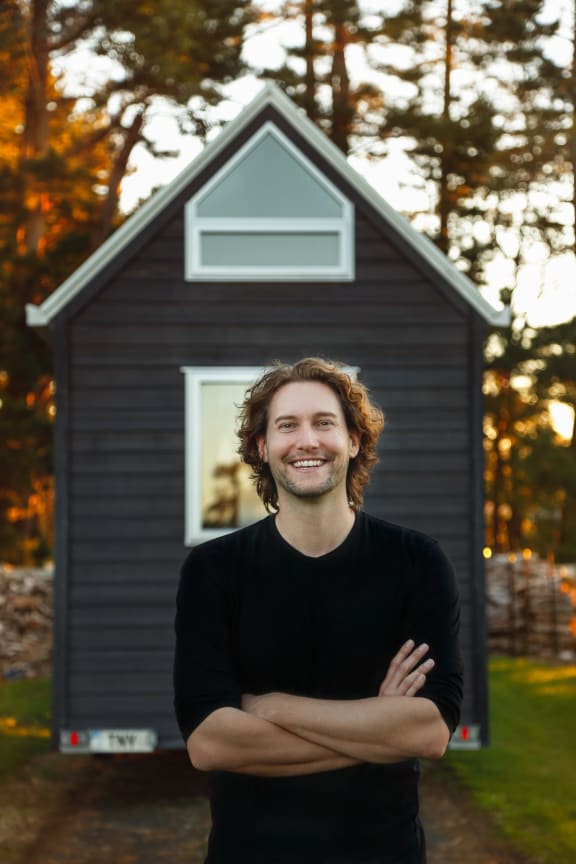
Bryce Langston Photo: supplied
"I felt like I had been priced out of the housing market in New Zealand, and this was something that I saw as being a very tangible solution for me."
For Langston, it was about being able to own a house without having to own the land.
"That is the gamechanger and that's really why I fell in love with tiny houses on wheels.
"If you're building a really high-quality tiny house using new materials and you're hiring people to do the labour … I'd say $100,000 would be a good budget, which is obviously a very substantial amount of change.
"For me this was something that was really achievable, it's given me a very beautiful, a very safe and a wonderful place for me to call home - it's something that I own and it's something that I'm able to own without debt."
And despite his size, it's worked well for him.
"I'm about six foot four so I'm perhaps one of the last people you would expect to live in a small space.
"One of the great things about building your own home is you get to absolutely build it to your own specifications - so even my kitchen sink is really high.
"In a small home that was designed for me, I'm actually much more comfortable than in a large home that is not specifically designed."
Check out Bryan's tiny house:
He says he worried at first about whether he could find a place to park his home, but quickly realised it was more a question of which place he wanted to park it.
"There are so many people who either have land and they're overextended on their mortgages and they love the idea of somebody parking up and giving them an extra $50 a week," he says.
"Or people who have large lifestyle properties who are struggling to maintain it who love the idea of having people on the property with them ... through to elderly people who love the idea of having somebody in close proximity that they can call out to for a hand every now and then."
Langston lives in the tiny home with his girlfriend, and says the mobility suits their lifestyle.
"You definitely have to like your partner if you're living in a tiny house.
"We're actually spending a lot of time travelling so we have a tiny house on wheels that's actually in the United States.
"When we're in that, we're on the road constantly. Really it's a place to sleep, it's a place to rest, but the rest of the time we're out there in the world exploring.
He says the freedom and mobility that's so attractive to him is more difficult to achieve in New Zealand than in the US, but certainly possible here too.
"Our road regulations are very very different to what they have over in the United States, so we're actually having to be a lot more cautious with our designs and how they're actually built over here.
"Certainly if you design a house for travel and you're meeting all of the road regulations there's no reason you can't hitch it up and tow it all over the country."
He says tiny houses on wheels are a little different from a caravan.
"The biggest difference is the way that it's constructed - so a caravan… they're built to travel, right, so they're aerodynamic, they're super lightweight, they tend to be constructed out of all synthetic materials and everything whereas a tiny house on wheels they're better insulated, they're framed more like conventional homes .. there's timber walls, timber exterior often."
"In my tiny house for example it's with a steel stud, but it's effectively a 2x4 framing, so a conventional sort of sized wall that you would find on any old house, there's a rain screen on it.
With the exception of the fact that it happens to be on wheels, from the trailer up it meets building code, he says.
Langston says tiny homes don't always have to be very mobile, and there are people around New Zealand working with the councils to build more permanently located tiny dwellings.
"While many councils are very progressive in New Zealand and around the world, there are areas where it's sort of a legal gray area," he says.
"A lot of councils are allowing consent for tiny homes so if people are actually purchasing land and want to be able to put their tiny homes there permanently they are being allowed to do that."
He acknowledges some councils are taking a more conservative approach, though.
"I think there's a fear from some councils especially in areas that are maybe a little more gentrified that the tiny house movement is like the new trailer park and that really couldn't be further from the truth.
"Really what there are, are very simple, very beautiful, well constructed safe homes for individuals and I think it's really just about creating a more effective dialogue with council to help them understand that."
He understands why someone living on a rural property in the country might not look kindly on a big group of tiny homes moving in next door, but says that doesn't seem likely.
"I've yet to see a development in New Zealand where there's six tiny houses on a rural property. It's more sort of there's one or two tiny homes on a big bit of property and they tend to be sort of well spaced out and well hidden from the neighbours."
He's optimistic about the movement however.
"There is something super cosy and romantic about being in a tiny house, they're wonderful, very very comfortable spaces.
"As it becomes more popular I'm sure more of these guidelines will be set, but one of the things that I talk about actually in the book is the need for us as pioneers to really take responsibility as early adopters of the tiny house movement."
Family of five in a tiny house
"That is a really phenomenal example of a space that is really really well designed.
"The way that he has actually constructed his kids rooms with all of the bunks sort of on top of one another where they've each got their own private space but a really sort of comfortable area to sleep and then this big communal area for the family - it was very clever.
"Good design is just absolutely imperative, and if you're willing to really examine the way that you use your space and design according for your needs, really the size is kind of irrelevant."
A home built during high school
"She was a Steiner student and in Steiner school in your last year you're able to do whatever project that you want … she decided that for her final year's project she was going to build a tiny house on wheels.
"She is incredibly talented. She had a little bit of help from her father who may be a little bit of a DIY-er but the vast bulk of it she actually did herself.
"She actually sold that house and she used the money from the sale of that house that she built as a student to actually build herself a second even more beautiful tiny house on wheels since.
"That's one of the great things about this sort of DIY movement - people have a bit more courage to get stuck into a tiny house build than they perhaps would a regular, much larger, much more expensive home. So they end up actually developing all of these skills that are just with them for life."
The castle house truck
"That is an incredible example of very very clever, clever design. Something that does actually move, they live in it full time, they travel, they're performers, and it's really really cool to see the lifestyle that they've built for themselves.
"It was built on the back of an old furniture moving truck and it was all designed so that there's turrets that fold out and the sides fold out and the roof raises up on hydraulics and it turns into something that looks like a tiny castle, people out there really do get creative and I just love seeing those.
Tiny House Japan
"What I loved about it was it was so small, it was so simple and yet so very beautiful.
"It was lightweight, it was very well constructed, beautifully designed in this kind of hybrid of Japanese design with some Frank Lloyd Wright kind of influence n there,
"Really incorporating a lot of principles about being able to look out on the world and connect with nature and all of that sort of thing,
"The builder ... had selected all of this beautiful heart cedar and matched all of the grain in the home, so that it was running in the same direction so there was no sort of thing to stop the eye from moving throughout the house.
"It was really beautifully done and you step into any home regardless of the size that has that level of craftsmanship and I challenge anyone not to have their breath just taken away.
